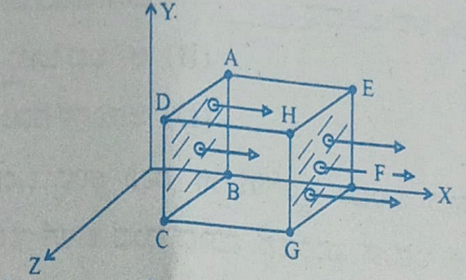In a simultaneous throw of a pair of dice, the probability of getting a total more than 7 is
- $\frac{7}{12}$
- $\frac{5}{36}$
- $\frac{5}{12}$
- $\frac{7}{36}$
The Correct Option is C
Solution and Explanation
$E = {(2, 6), (3, 5), (3, 6), (4, 4), (4, 5), (4, 6), (5, 3), (5, 4), (5, 5), (5, 6), (6, 2), (6, 3), (6, 4), (6, 5), (6, 6)} $
$\therefore\, P(E) =\frac{n(E)}{n(S)} = \frac{15}{36} = \frac{5}{12}$
Top Questions on Conditional Probability
- The probability that a student passes only in Mathematics is \(\frac{1}{3}\).The probability that the student passes only in English is \(\frac{4}{9}\).The probability that the student passes in both of these subjects \(\frac{1}{6}\).The probability that the student will pass in at least one of these two subjects is
- GATE CE - 2024
- Engineering Mathematics
- Conditional Probability
- If $A$ and $B$ are two events such that $P ( A )=\frac{1}{3}, P ( B )=\frac{1}{5}$ and $P ( A \cup B )=\frac{1}{2}$, then $P \left( A \mid B ^{\prime}\right)+ P \left( B \mid A ^{\prime}\right)$ is equal to
- JEE Main - 2023
- Mathematics
- Conditional Probability
- If A and B are events such that P(A)=\(\frac{1}{4}\), P(A/B)=\(\frac{1}{2}\) and P(B/A)=\(\frac{2}{3}\) then P(B) is
- KCET - 2023
- Mathematics
- Conditional Probability
- n objects are distributed at random among n persons. The number of ways in which this can be done so that at least one of them will not get any object is
- WBJEE - 2023
- Mathematics
- Conditional Probability
- A bag contains 2n + 1 coins. It is known that n of these coins have head on both sides whereas the other n + 1 coins are fair. One coin is selected at random and tossed. If the probability that toss results in heads is \(\frac{31}{42}\), then the value of n is
- KCET - 2023
- Mathematics
- Conditional Probability
Questions Asked in KCET exam
- The current in a coil changes from 2A to 5A in 0.3s. The magnitude of emf induced in the coil is 1.0V. The value of self-inductance of the coil is
- KCET - 2023
- Electromagnetic induction
- A stretched wire of a material whose Young's modulus Y = 2 × 1011 Nm-2 has Poisson's ratio of 0.25. Its lateral strain εl = 10-3. The elastic energy density of the wire is
- KCET - 2023
- mechanical properties of solids
- A particle moves along the curve \(\frac{x^2}{16}+\frac{y^2}{4}=1\). When the rate of change of abscissa is 4 times that of its ordinate, then the quadrant in which the particle lies is
- KCET - 2023
- Conic sections
- A point object is moving at a constant speed of 1 ms-1 along the principal axis of a convex lens of focal length 10cm. The speed of the image is also 1 ms-1 , when the object is at _______ cm from the optic centre of the lens.
- KCET - 2023
- spherical lenses
- A cubical Gaussian surface has side of length a = 10 cm. Electric field lines are parallel to x-axis as shown. The magnitudes of electric fields through surfaces ABCD and EFGH are 6kNC-1 and 9kNC-1 respectively. Then the total charge enclosed by the cube is
[Take ε0 = 9 × 10-12 Fm-1]
- KCET - 2023
- Gauss Law
Concepts Used:
Conditional Probability
Conditional Probability is defined as the occurrence of any event which determines the probability of happening of the other events. Let us imagine a situation, a company allows two days’ holidays in a week apart from Sunday. If Saturday is considered as a holiday, then what would be the probability of Tuesday being considered a holiday as well? To find this out, we use the term Conditional Probability.
Let’s discuss certain theorems of Conditional Probability:
- Let us consider a random experiment where the sample space S is considered as space and two events namely A and B happen there. Then, the formula would be:
P(S | B) = P(B | B) = 1.
Proof of the same: P(S | B) = P(S ∩ B) ⁄ P(B) = P(B) ⁄ P(B) = 1.
[S ∩ B indicates the outcomes common in S and B equals the outcomes in B].
- Now let us consider any two events namely A and B happening in a sample space ‘s’, then, P(A ∩ B) = P(A).
P(B | A), P(A) >0 or, P(A ∩ B) = P(B).P(A | B), P(B) > 0.
This theorem is named as the Multiplication Theorem of Probability.
Proof of the same: As we all know that P(B | A) = P(B ∩ A) / P(A), P(A) ≠ 0.
We can also say that P(B|A) = P(A ∩ B) ⁄ P(A) (as A ∩ B = B ∩ A).
So, P(A ∩ B) = P(A). P(B | A).
Similarly, P(A ∩ B) = P(B). P(A | B).
The interesting information regarding the Multiplication Theorem is that it can further be extended to more than two events and not just limited to the two events. So, one can also use this theorem to find out the conditional probability in terms of A, B, or C.
Read More: Types of Sets
Sometimes students get confused between Conditional Probability and Joint Probability. It is essential to know the differences between the two.



